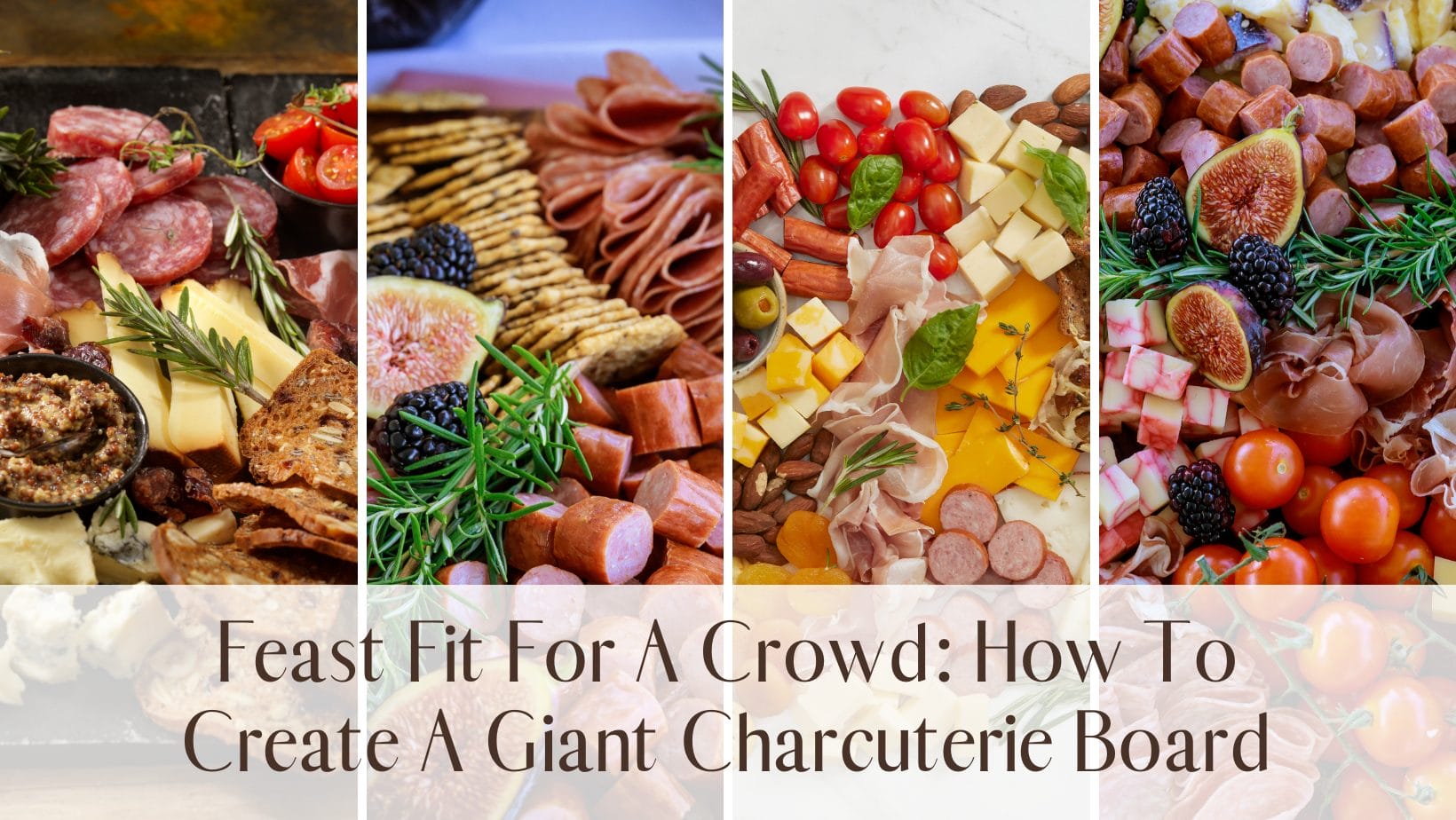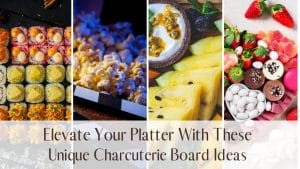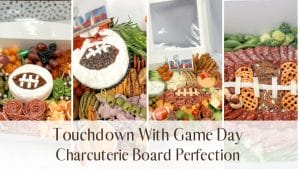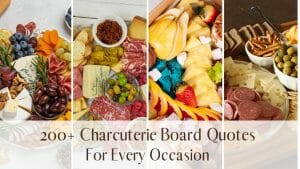Welcome to the ultimate guide on crafting a giant charcuterie board! Whether you're hosting a festive gathering, planning a wedding, or simply want to impress your guests, a beautifully arranged giant charcuterie board is the perfect centerpiece. In this guide, we'll walk you through everything you need to know—from selecting the right size and shape to assembling a board that dazzles with a variety of cheeses, meats, and unique ingredients. Get ready to elevate your entertaining game with creative ideas, expert tips, and the latest trends in charcuterie boards. Let’s dive in and make your next event unforgettable!
TIP: Unlock the art of charcuterie quickly and join over 514K enthusiasts! Click here to elevate your food art game now >>
Table of Contents [CLICK HERE TO OPEN]
- Choosing the Perfect Size and Shape for Your Giant Charcuterie Board
- Essential Ingredients for a Giant Charcuterie Board
- Innovative and Specialty Items to Elevate Your Board
- Step-by-Step Guide: How to Assemble a Giant Charcuterie Board
- Tips for Serving and Presenting Your Giant Charcuterie Board
- Event-Specific Giant Charcuterie Board Ideas
- Where To Buy Giant Charcuterie Boards
- Wrapping It Up
- Frequently Asked Questions
Choosing the Perfect Size and Shape for Your Giant Charcuterie Board
Creating a giant charcuterie board involves more than just filling it with delicious items; the size and shape of the board play a crucial role in its effectiveness and visual appeal. Here’s how to choose the perfect size and shape for your next charcuterie masterpiece.
Determining the Right Size
Factors to Consider Based on the Number of Guests and Space
- Number of Guests:
- Small Gatherings (Up to 20 People): For smaller groups, a board that's around 18 to 24 inches in diameter or 24 to 30 inches long is usually sufficient. This size allows for a generous spread of ingredients while remaining manageable.
- Medium Gatherings (20 to 50 People): Opt for a board that is 30 to 36 inches long or 24 to 30 inches in diameter. This size provides ample space for a variety of cheeses, meats, fruits, and other accompaniments, ensuring that there’s something for everyone.
- Large Gatherings (50 to 100 People): For larger events, consider using multiple boards or a board that's 36 inches or more in length. This size accommodates a broader selection of items and ensures that the board remains visually appealing and accessible.
- Available Space:
- Table Size and Arrangement: Ensure the board fits comfortably on your serving table or area. It should allow guests to access it from all sides, promoting easy serving and interaction.
- Event Type: For sit-down dinners or formal events, a slightly smaller board may be ideal to avoid overwhelming guests. For casual gatherings or buffets, a larger board can become a focal point and conversation starter.
Examples of Different Sizes and Their Ideal Uses
- 18 to 24 Inches in Diameter (Round) or 24 to 30 Inches Long (Rectangular): Ideal for intimate gatherings or smaller parties. Perfect for serving a selection of 4 to 6 types of cheeses, 2 to 4 types of meats, and a variety of fruits and nuts.
- 30 to 36 Inches Long (Rectangular) or 24 to 30 Inches in Diameter (Round): Suitable for medium-sized gatherings. Allows for a more extensive range of ingredients, including additional spreads, olives, and pickles.
- 36 Inches or More (Rectangular) or Extra-Large Round Boards: Best for large events. This size supports a vast assortment of items, making it a centerpiece for substantial gatherings, with room for creative and varied presentations.
Selecting the Best Shape
Popular Shapes and Their Visual Impact
- Rectangular Boards:
- Visual Impact: Rectangular boards offer a sleek, modern look and provide a structured space for arranging ingredients in rows or sections. This shape is ideal for creating a visually organized display.
- Serving Benefits: Easy to place against a wall or on a long table. It allows for a more organized layout where guests can access different sections of the board without crowding.
- Round Boards:
- Visual Impact: Round boards create a more casual and elegant presentation, often viewed as more approachable. They encourage guests to gather around the board and interact more freely.
- Serving Benefits: Ideal for centerpieces on round tables or as focal points on larger tables. The round shape promotes a 360-degree access point, making it easier for guests to serve themselves from all angles.
- Square or Oval Boards:
- Visual Impact: Square and oval boards offer a unique and stylish alternative. Square boards can make the display feel more structured, while oval boards offer a balance between traditional round and rectangular shapes.
- Serving Benefits: Suitable for creating a modern or bespoke look. Square boards fit well in corners or along the edges of tables, while oval boards offer a mix of the benefits of both round and rectangular shapes.
How Shape Affects Presentation and Serving
- Presentation: The shape of the board influences the arrangement and flow of the ingredients. Rectangular boards lend themselves to organized rows or sections, while round and oval boards allow for a more freeform, scattered approach.
- Serving: Shape impacts how guests interact with the board. Round boards encourage guests to move around and socialize, while rectangular boards are better for organized serving, especially when used on a long table where access from multiple sides is beneficial.
By carefully selecting the right size and shape, you can ensure your giant charcuterie board not only looks stunning but also functions effectively for your gathering. Whether you choose a grand rectangular display or a charming round board, the right choice will enhance the overall experience for your guests.
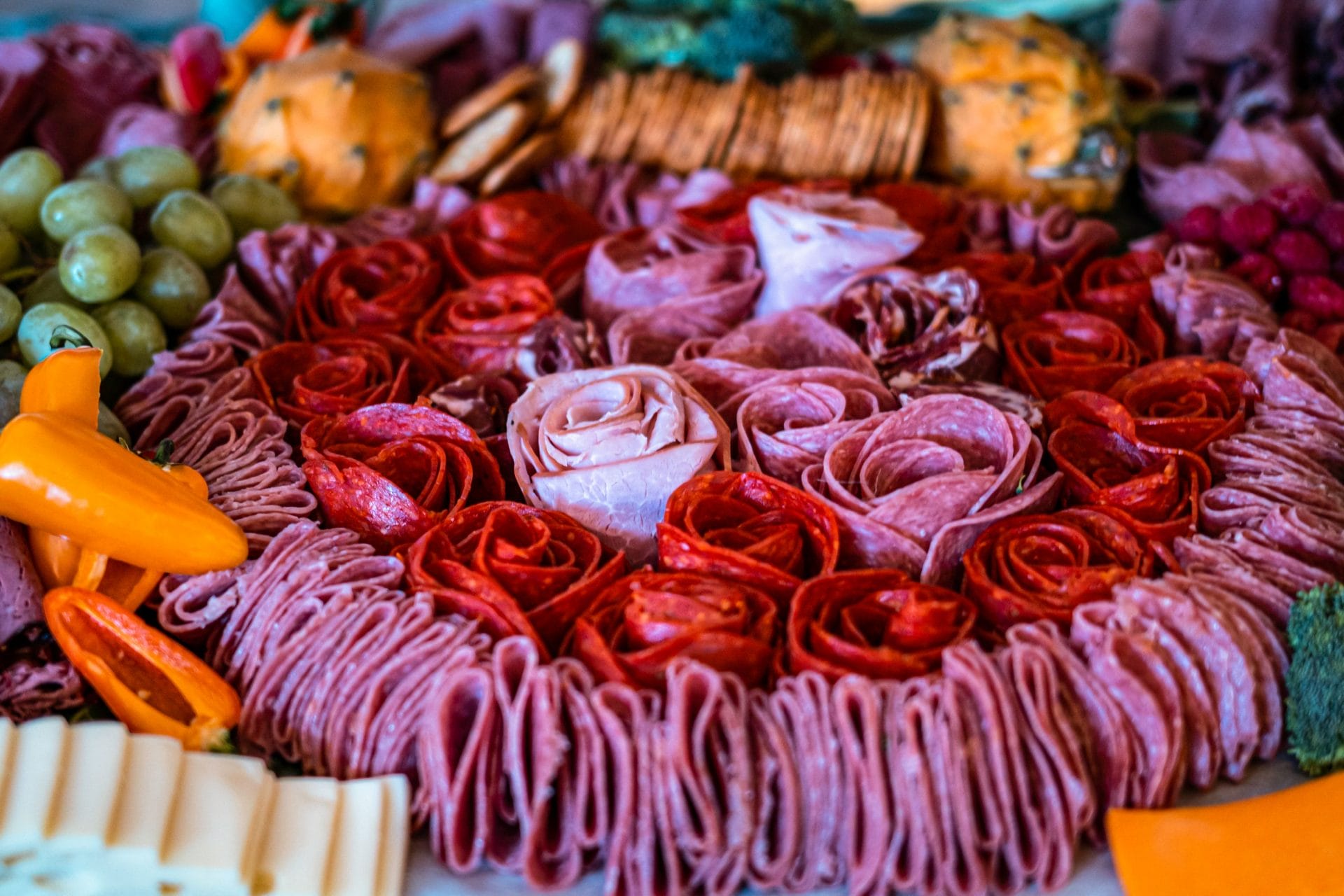
Essential Ingredients for a Giant Charcuterie Board
A giant charcuterie board is a feast for both the eyes and the palate, featuring a variety of ingredients that cater to different tastes and preferences. Here’s how to select and arrange essential ingredients to create a well-rounded and impressive board.
Cheeses: Types and Varieties
Popular Cheese Choices for a Giant Board
- Cheddar:
- Details: A classic cheese with a sharp, tangy flavor. Opt for aged cheddar for a more robust taste.
- Pairing: Complements fruits like apples and pears, and pairs well with hearty crackers.
- Brie:
- Details: A soft, creamy cheese with a mild, buttery flavor. Brie adds a luxurious texture to your board.
- Pairing: Pairs nicely with fresh berries and nuts, and works well with light crackers or baguette slices.
- Gouda:
- Details: A semi-hard cheese with a sweet, nutty flavor. Gouda can be found in both young and aged varieties.
- Pairing: Works well with figs, grapes, and savory meats like salami.
- Blue Cheese:
- Details: A strong, tangy cheese with a crumbly texture. Blue cheese adds a bold flavor to the board.
- Pairing: Pairs well with sweet fruits like pears and apples, and is excellent with honey or balsamic reduction.
- Manchego:
- Details: A Spanish cheese with a firm texture and a nutty, buttery flavor.
- Pairing: Complements olives and almonds, and goes well with crusty bread.
How to Select a Mix of Textures and Flavors
- Texture Variety: Combine soft cheeses (like Brie) with semi-hard (like Gouda) and hard cheeses (like aged Cheddar). This variety ensures a satisfying range of textures, from creamy to crumbly.
- Flavor Balance: Mix mild cheeses with stronger flavors. For instance, pair a mild cheese like Brie with a bold option like Blue Cheese. This contrast will cater to different taste preferences and enhance the overall experience.
Meats: Options and Pairings
Best Meats to Include
- Prosciutto:
- Details: An Italian dry-cured ham with a delicate, savory flavor. Thinly sliced for easy snacking.
- Pairing: Complements soft cheeses like Brie and fresh fruits like melon or figs.
- Salami:
- Details: A cured sausage with a variety of flavors and textures. Choose from classic, spicy, or herb-infused options.
- Pairing: Pairs well with Gouda and Cheddar, as well as pickles and olives.
- Chorizo:
- Details: A spicy, cured sausage that adds a robust flavor to the board. Available in Spanish and Mexican varieties.
- Pairing: Works well with Manchego and crusty bread, and is a good match for bold, tangy spreads.
- Capicola:
- Details: A dry-cured pork shoulder with a spicy, slightly sweet flavor. Thinly sliced for ease of serving.
- Pairing: Pairs nicely with sharp Cheddar and tangy mustard.
Pairing Meats with Cheeses and Other Ingredients
- Complementary Flavors: Match the spiciness of Chorizo with mild cheeses like Gouda, and balance the richness of Prosciutto with the tanginess of Blue Cheese.
- Textural Balance: Pair leaner meats like Prosciutto with creamy cheeses and richer meats like Salami with firmer cheeses to create a balanced taste experience.
Fruits, Nuts, and Spreads
Essential Fruits and Nuts to Enhance the Board
- Fruits:
- Grapes: Sweet and easy to eat, they complement almost all cheeses.
- Apples and Pears: Provide a crisp texture and sweetness that pairs well with a variety of cheeses.
- Berries: Strawberries, blueberries, and raspberries add a burst of flavor and color.
- Nuts:
- Almonds: Offer a crunchy texture and mild flavor that pairs well with both cheeses and meats.
- Walnuts: Add a rich, slightly bitter flavor that complements Blue Cheese and sharp Cheddar.
- Cashews: Provide a creamy, buttery flavor that works well with a variety of cheeses.
Popular Spreads and Condiments to Add Variety
- Spreads:
- Hummus: A versatile and creamy option that pairs well with both cheeses and vegetables.
- Fig Jam: Adds a sweet, fruity contrast that pairs beautifully with salty cheeses and cured meats.
- Condiments:
- Mustards: Include a variety such as whole grain or spicy Dijon to add tanginess and complexity.
- Honey: A sweet complement to sharp cheeses like Blue Cheese and a great contrast to salty meats.
By thoughtfully selecting and arranging these essential ingredients, you’ll create a giant charcuterie board that not only looks impressive but also offers a delightful array of flavors and textures for your guests to enjoy.

Innovative and Specialty Items to Elevate Your Board
Creating a giant charcuterie board offers an opportunity to showcase not just a selection of tasty foods but also unique and specialty items that can make your presentation truly remarkable. Here’s how to incorporate innovative ingredients and find the best quality items to elevate your board.
Unique Ingredients for a Show-Stopping Board
Examples of Specialty Items
- Artisanal Crackers and Breadsticks:
- Details: Opt for crackers with unique flavors, such as rosemary sea salt or black sesame. Consider including handcrafted breadsticks with herbs or spices.
- Impact: These specialty crackers and breadsticks add texture and a touch of gourmet flair, enhancing both the visual appeal and flavor variety of your board.
- Exotic Fruits:
- Details: Include fruits like dragon fruit, starfruit, or rambutan. These visually striking fruits not only add vibrant colors but also offer unique flavor profiles.
- Impact: Exotic fruits create visual interest and intrigue, making your board stand out and providing guests with an exciting tasting experience.
- Gourmet Cheeses and Meats:
- Details: Look for artisanal cheeses such as truffle-infused brie or aged manchego. Incorporate cured meats like bresaola or speck for added sophistication.
- Impact: Specialty cheeses and meats elevate the flavor profile of your board, making it a memorable experience for guests who appreciate fine foods.
- Specialty Spreads and Dips:
- Details: Include unique spreads like fig and olive tapenade or spicy harissa hummus. These can be served in small bowls alongside your board.
- Impact: Specialty spreads introduce new flavor combinations and enhance the tasting experience, offering a gourmet touch.
- Decorative Edible Flowers and Herbs:
- Details: Use edible flowers like pansies or nasturtiums, and fresh herbs such as rosemary or thyme for garnish.
- Impact: Edible flowers and herbs add a touch of elegance and a burst of color, making your board look more artistic and appealing.
How These Items Can Make Your Board Stand Out
Incorporating these innovative ingredients can transform a standard charcuterie board into a visually stunning and memorable centerpiece. Specialty items not only enhance the aesthetic appeal but also offer unique taste experiences that set your board apart from typical offerings. By choosing high-quality, unusual items, you create a conversation piece that guests will rave about.
Sourcing Quality Ingredients
Tips for Finding High-Quality and Unique Items
- Visit Local Farmers’ Markets and Artisan Shops:
- Details: Farmers' markets often feature local, artisanal products such as handcrafted cheeses, specialty meats, and exotic fruits. Artisan shops and gourmet stores can provide unique crackers, spreads, and other specialty items.
- Benefit: These sources offer fresh, high-quality ingredients and often feature unique products not found in standard grocery stores.
- Explore Specialty Food Stores and Online Retailers:
- Details: Stores that specialize in gourmet foods, such as cheese shops or spice stores, are excellent for finding unique items. Online retailers like Goldbelly or specialty grocery websites also offer a wide range of high-quality ingredients.
- Benefit: Specialty stores and online options provide access to a broader selection of unique and high-quality products.
- Look for Recommendations from Food Enthusiasts and Influencers:
- Details: Follow food bloggers, chefs, and influencers who share reviews and recommendations for specialty items. Their insights can lead you to excellent sources and new products.
- Benefit: Leveraging the knowledge of food experts can help you discover high-quality items and reputable suppliers.
- Attend Food Festivals and Tastings:
- Details: Food festivals and tastings are great opportunities to sample and purchase gourmet products directly from producers.
- Benefit: These events allow you to taste products before buying and often offer exclusive items that are not widely available.
Recommended Sources and Suppliers
- Local Farmers’ Markets: Check for weekly markets in your area for fresh and unique local products.
- Specialty Grocery Stores: Stores like Whole Foods, Trader Joe’s, and local gourmet shops.
- Online Retailers: Websites like Murray’s Cheese, Igourmet, or Amazon for specialty foods.
- Artisan Food Producers: Explore producers such as Cowgirl Creamery or La Quercia for artisanal cheeses and meats.
By selecting innovative and high-quality ingredients, you can create a giant charcuterie board that not only satisfies but also delights and impresses your guests, turning an ordinary spread into an extraordinary experience.
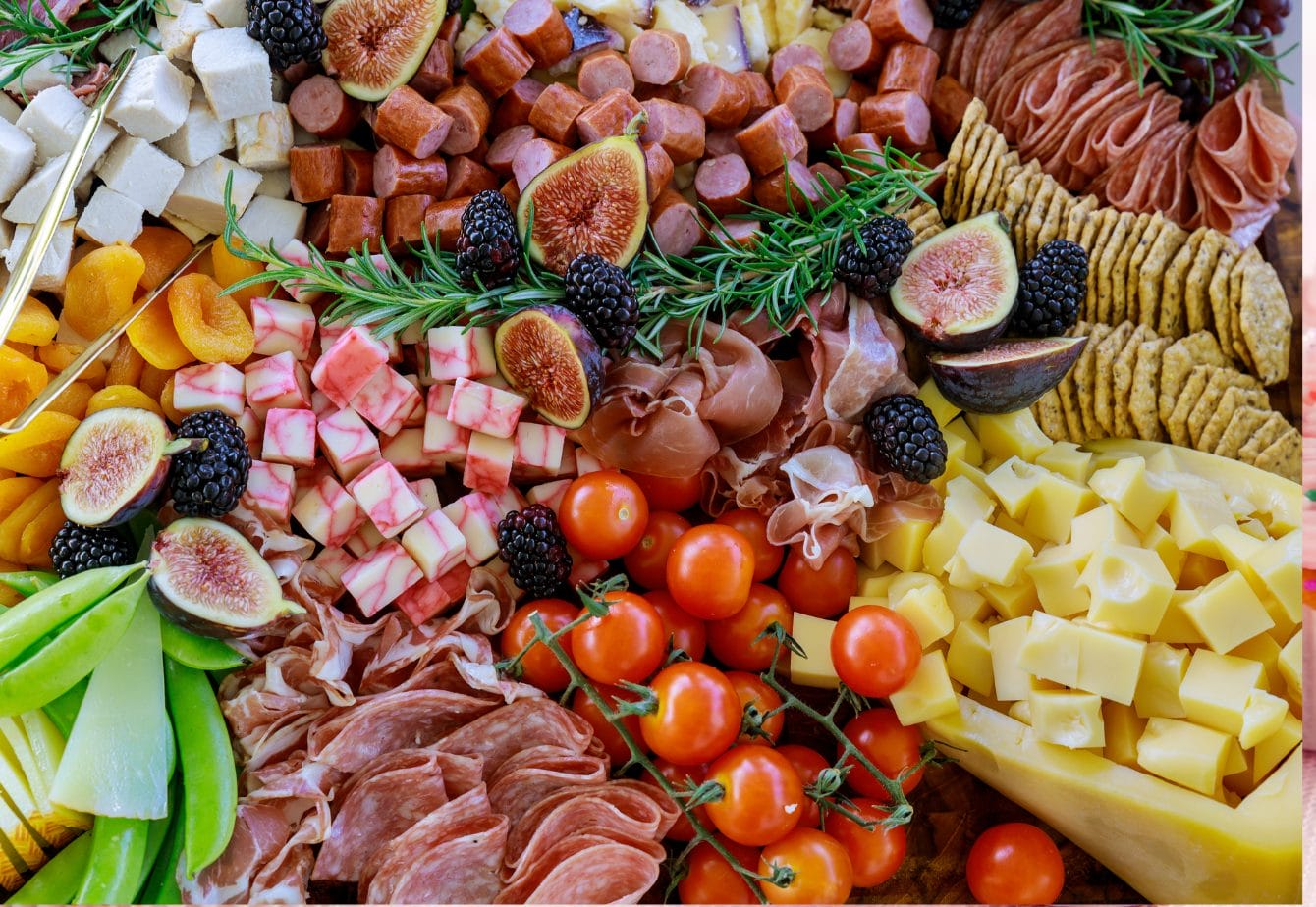
Step-by-Step Guide: How to Assemble a Giant Charcuterie Board
Creating a giant charcuterie board is both an art and a science. The key to a successful board lies in thoughtful planning, strategic arrangement, and a keen eye for design. Here’s a comprehensive step-by-step guide to help you assemble an eye-catching and delicious giant charcuterie board.
Planning Your Layout
Tips for Arranging Ingredients Attractively
- Start with a Central Focus:
- Begin by choosing a central item to anchor your board, such as a large wheel of cheese or a bowl of a specialty spread. This item will act as the focal point around which you arrange the other ingredients.
- Create Zones:
- Divide the board into zones or sections for different types of ingredients. For example, allocate areas for cheeses, meats, fruits, nuts, and spreads. This organization helps with visual appeal and makes it easier for guests to navigate.
- Use Varying Heights:
- Incorporate elements of different heights to create visual interest. Use small bowls or stands to elevate some items, like dips or cheeses, which adds dimension and draws the eye.
Balancing Flavors, Textures, and Colors
- Flavor Balance:
- Combine a mix of flavors: sweet (fruits, honey), savory (cheeses, meats), tangy (pickles, olives), and spicy (mustards, hot peppers). This variety ensures that there’s something for every palate.
- Texture Variety:
- Include a range of textures such as creamy cheeses, crunchy nuts, and chewy dried fruits. This balance adds depth to the tasting experience.
- Color Coordination:
- Arrange ingredients to create a visually appealing contrast of colors. Place vibrant fruits like berries and melon next to rich-colored cheeses and meats to make the board more inviting.
Arranging Ingredients: Step-by-Step
Detailed Instructions on How to Place Cheeses, Meats, Fruits, and Other Items
- Cheeses:
- Placement: Arrange cheeses in different areas of the board, spreading them out to avoid crowding. Place larger wedges or wheels at the center or edges, and slice or cube smaller cheeses for easy access.
- Spacing: Leave space between different types of cheese to avoid flavor mixing and make it easier for guests to serve themselves.
- Meats:
- Placement: Fold or roll slices of meats like prosciutto and salami into visually appealing shapes. Arrange them in clusters or overlapping rows to create a layered effect.
- Spacing: Position meats near complementary cheeses and condiments to enhance flavor pairings.
- Fruits:
- Placement: Scatter fruits throughout the board, grouping similar types together. Place larger fruits like apples and pears in the center or at focal points, and scatter smaller fruits like grapes and berries around.
- Spacing: Ensure fruits are easily accessible and don’t overcrowd other items. Use small bowls for cut fruits or berries if necessary.
- Nuts and Spreads:
- Placement: Position bowls of spreads like hummus or jam in accessible areas, ideally near cheese and crackers. Scatter nuts in small clusters around the board to fill gaps and add texture.
- Spacing: Keep spreads within reach of the cheese and meats they pair well with, and place nuts in areas that complement the overall layout.
Visual Tips for Creating an Appealing Design
- Symmetry vs. Asymmetry: Decide whether you want a symmetrical layout for a more formal look or an asymmetrical arrangement for a more casual, dynamic presentation.
- Use of Garnishes: Add fresh herbs, edible flowers, or small sprigs of greenery to fill gaps and enhance the board’s visual appeal.
- Utilize Empty Space: Ensure there is some open space on the board to avoid a cluttered look. Empty spaces can be visually appealing and make the board look more organized.
DIY vs. Professional Charcuterie Boards
Advantages and Disadvantages of Making Your Own vs. Hiring a Professional
- DIY Charcuterie Boards:
- Advantages:
- Customization: You have complete control over the selection of ingredients and presentation.
- Cost-Effective: Generally more affordable than hiring a professional.
- Creativity: Allows for personal expression and creativity in design.
- Disadvantages:
- Time-Consuming: Requires significant time for planning, shopping, and assembly.
- Experience Required: May lack the professional touch if you’re not experienced in food presentation.
- Advantages:
- Professional Charcuterie Boards:
- Advantages:
- Expertise: Professionals have experience in creating visually stunning and well-balanced boards.
- Convenience: Saves time and effort, as professionals handle all aspects of preparation and presentation.
- High-Quality Ingredients: Access to premium products and specialized items.
- Disadvantages:
- Cost: Typically more expensive than creating the board yourself.
- Less Control: Limited ability to customize the board to your exact preferences.
- Advantages:
Cost Considerations and Time Commitment
- DIY Costs: Primarily include the cost of ingredients and any additional supplies like boards and serving tools. Time commitment involves shopping, prepping, and assembling the board.
- Professional Costs: Include the cost of the service and the premium pricing of high-quality ingredients. Time commitment is minimal as the professional handles the work.
Whether you choose to create your own giant charcuterie board or hire a professional, careful planning and attention to detail will ensure a delicious and impressive presentation.
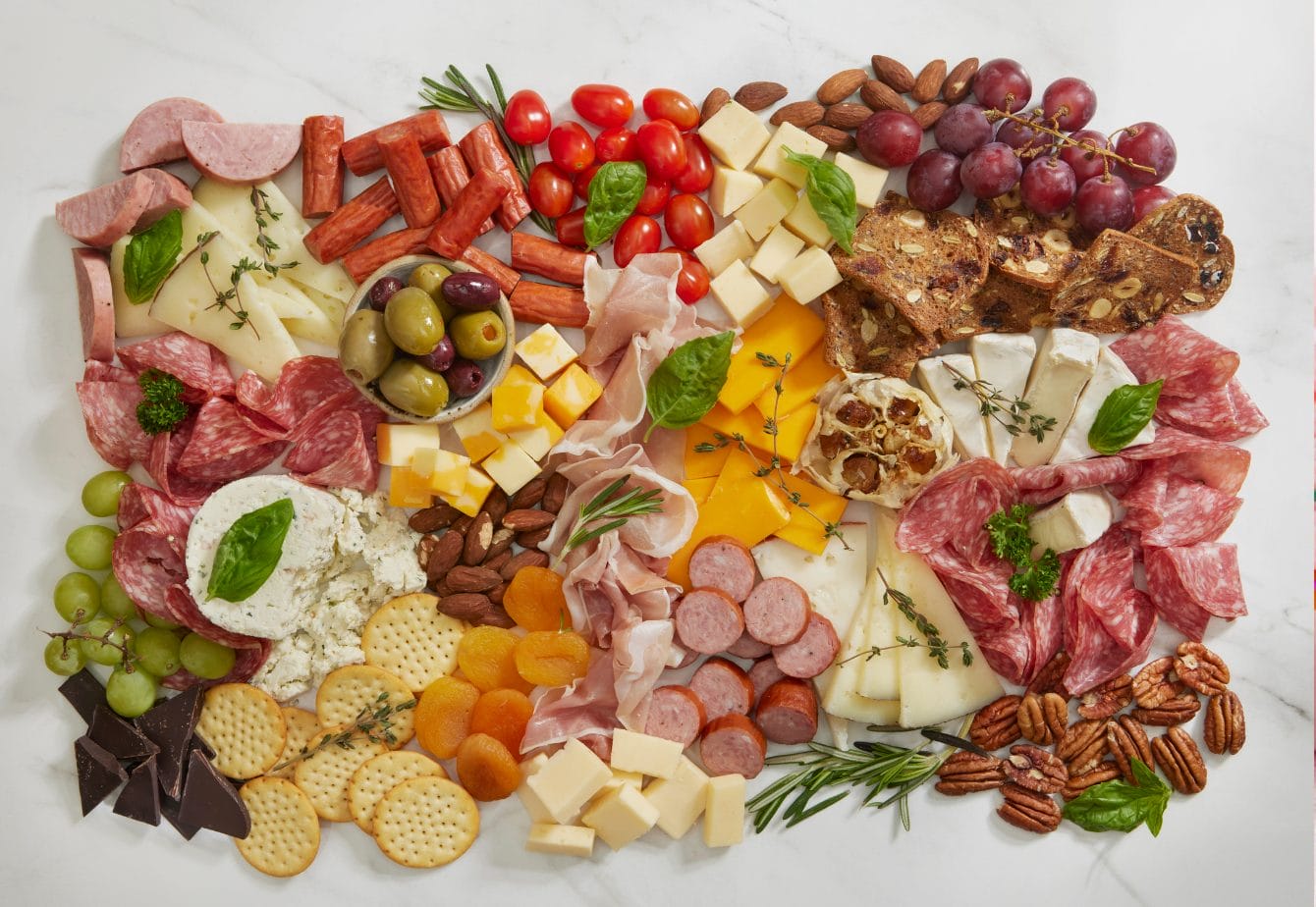
Tips for Serving and Presenting Your Giant Charcuterie Board
A giant charcuterie board is not just a feast for the taste buds but also a visual centerpiece. To ensure it stays fresh and looks impressive throughout your event, follow these best practices for serving and presentation.
Best Practices for Serving
How to Ensure the Board Remains Fresh and Appealing
- Temperature Control:
- Cheeses and Meats: Keep perishable items like cheeses and meats at the proper temperature. Use cooling trays or ice packs placed under the board to maintain freshness, especially if the board will be out for an extended period.
- Refrigeration: If possible, assemble the board just before serving to maintain optimal freshness. Store leftovers promptly in the refrigerator to avoid spoilage.
- Covering and Protection:
- During Prep: Cover the board with plastic wrap or a large lid while you are preparing it to keep the ingredients from drying out.
- During Service: If the board will be outside or exposed to the air for a long time, use clear food covers or a large, clean cloth to protect it from contamination.
- Handling and Refreshing:
- Refill as Needed: Monitor the board and replenish items that are running low. This keeps the board looking full and inviting.
- Rearrange: Occasionally rearrange items to refresh the look and ensure everything remains appealing and accessible.
Serving Tools and Accessories to Consider
- Serving Utensils:
- Cheese Knives: Use a variety of cheese knives for different types of cheese, such as soft cheese spreaders and hard cheese slicers.
- Tongs and Spoons: Provide tongs for meats and spoons for spreads to make it easy for guests to serve themselves without contaminating the board.
- Small Bowls and Plates:
- For Condiments and Spreads: Use small bowls for dips, spreads, and condiments to keep them organized and easy to access.
- For Extra Ingredients: Have a few extra small plates or bowls on hand for guests to use for their personal servings of nuts, fruits, and other items.
- Cutting Boards and Trays:
- Multiple Boards: If you’re serving a large number of guests, consider using multiple boards or trays to ensure there’s enough space for everyone to enjoy the selection without crowding.
Creating an Impressive Presentation
Techniques for Enhancing the Visual Appeal
- Layering and Height:
- Elevate Items: Use stands, risers, or small boxes covered in decorative cloths to create varying heights on the board. This adds depth and visual interest to the arrangement.
- Layer Ingredients: Layer items in groups or clusters rather than spreading them out evenly. This creates a more dynamic and appealing look.
- Balanced Arrangement:
- Symmetry and Asymmetry: Use symmetry for a classic look or asymmetry for a more contemporary and artistic presentation. Both approaches can be visually appealing depending on the overall theme and style.
- Color Contrast: Arrange ingredients to create contrast in color. For example, place dark olives next to bright red tomatoes or vibrant berries against creamy cheeses.
Ideas for Garnishes and Decorative Elements
- Fresh Herbs:
- Details: Scatter fresh herbs like rosemary, thyme, or basil across the board. They add a pop of green and enhance the aroma and visual appeal.
- Usage: Use herbs to fill in gaps and add a touch of elegance to the presentation.
- Edible Flowers:
- Details: Incorporate edible flowers such as pansies, nasturtiums, or marigolds for a decorative touch.
- Usage: Place flowers strategically around the board to add vibrant colors and a touch of sophistication.
- Seasonal Accents:
- Details: Depending on the season, use elements like small pumpkins, pinecones, or citrus slices for a themed touch.
- Usage: Align seasonal accents with the theme of the event or the time of year to enhance the overall atmosphere.
- Decorative Boards and Platters:
- Details: Use beautifully designed boards, platters, or trays that complement the ingredients and add to the visual appeal.
- Usage: Choose boards that match the event’s theme or add a touch of elegance, such as marble or wooden boards.
By following these tips for serving and presenting your giant charcuterie board, you’ll ensure that it remains fresh, visually stunning, and a highlight of your event. Whether it’s for a casual gathering or a formal celebration, these practices will help you create a memorable and enjoyable experience for your guests.

Event-Specific Giant Charcuterie Board Ideas
A giant charcuterie board can be customized to suit a variety of events, from elegant weddings to festive holiday parties. Tailoring your board to fit the specific occasion enhances its appeal and makes it a standout feature of the event. Here are some tailored ideas for different types of gatherings.
Charcuterie Boards for Weddings and Formal Events
Ideas for Elegant and Sophisticated Presentations
- Luxurious Ingredients:
- Cheeses: Include high-end options like truffle-infused Brie, aged Comté, or a selection of artisanal cheeses.
- Meats: Opt for premium cured meats such as Prosciutto di Parma, Iberico ham, or duck breast.
- Garnishes: Use edible flowers, gold leaf, or elegant herbs like rosemary and thyme to enhance the presentation.
- Elegant Serving Trays:
- Materials: Choose sophisticated serving trays or boards made of marble, slate, or polished wood.
- Design: Arrange items in a visually appealing manner with attention to symmetry and balance.
- Customized Touches:
- Monogrammed Elements: Incorporate monogrammed cheese knives, personalized labels for cheeses and meats, or custom boards with the couple’s names or event date.
- Decorative Accents: Add candles, small floral arrangements, or elegant place settings around the board.
Tailoring the Board to Fit the Theme and Style of the Event
- Color Scheme:
- Match Colors: Align the board’s color palette with the wedding or event colors. For example, use fruits and flowers in shades that complement the event decor.
- Decorative Themes: For a vintage wedding, incorporate classic ingredients and rustic wooden boards. For a modern affair, opt for sleek, minimalistic designs with clean lines.
- Menu Integration:
- Event Cuisine: Integrate elements that reflect the event’s cuisine or style. For a Mediterranean-themed wedding, include cheeses and meats from the region, along with olives, nuts, and flatbreads.
Holiday and Seasonal Charcuterie Boards
Incorporating Seasonal Ingredients and Themes
- Seasonal Fruits and Vegetables:
- Winter: Use ingredients like pomegranates, apples, and citrus fruits. Include roasted nuts and root vegetables.
- Spring: Incorporate fresh berries, asparagus, and radishes. Use light cheeses and delicate herbs.
- Holiday-Specific Additions:
- Christmas: Add holiday-themed items like cranberry sauce, spiced nuts, and festive cookies. Use decorative elements like small ornaments or holiday-themed napkins.
- Thanksgiving: Include seasonal ingredients such as pumpkin spice spreads, apple slices, and pecan pie bites.
Festive Ideas for Special Occasions
- Decorative Elements:
- Holiday Colors: Use ingredients that reflect holiday colors, like red and green fruits for Christmas or orange and purple for Halloween.
- Themed Garnishes: Add seasonal decorations such as small pumpkins for autumn or edible glitter for New Year’s.
- Interactive Components:
- DIY Stations: Set up a small area where guests can create their own custom bites with various ingredients, like cheese and meat pairings or mini sandwiches.
- Themed Games: Incorporate playful elements related to the holiday, such as a cheese “tasting challenge” for Christmas or a “guess the spice” game for Thanksgiving.
Kids’ Parties and Family Gatherings
Creating a Kid-Friendly and Family-Oriented Board
- Simple and Fun Ingredients:
- Cheeses: Use mild, kid-friendly cheeses like cheddar, mozzarella, and gouda. Cut into fun shapes or bite-sized pieces.
- Meats: Offer mild, easy-to-eat options like turkey slices or ham. Avoid overly spicy or complex meats.
- Interactive and Playful Elements:
- DIY Skewers: Provide skewers and a selection of ingredients (cheese cubes, fruit slices, crackers) so kids can make their own mini creations.
- Fun Shapes: Use cookie cutters to shape cheeses, fruits, and sandwiches into fun shapes like stars or animals.
Suggestions for Interactive or Playful Elements
- Themed Boards:
- Color Themes: Create a board with a specific color theme or favorite characters from popular kids’ shows or movies.
- Character Edibles: Use ingredients that fit a theme, such as “dinosaur” shaped sandwiches or “princess” themed fruits and treats.
- Activity Stations:
- Build-Your-Own: Set up stations where kids can build their own mini charcuterie plates with a variety of ingredients.
- Craft Area: Include a small area with craft supplies for kids to decorate their own plates or create edible art.
By customizing your giant charcuterie board to suit the specific occasion, you enhance its appeal and make it a memorable part of your event. Whether you’re hosting a sophisticated wedding, a festive holiday party, or a fun family gathering, these tailored ideas will help you create an exceptional and enjoyable experience for your guests.
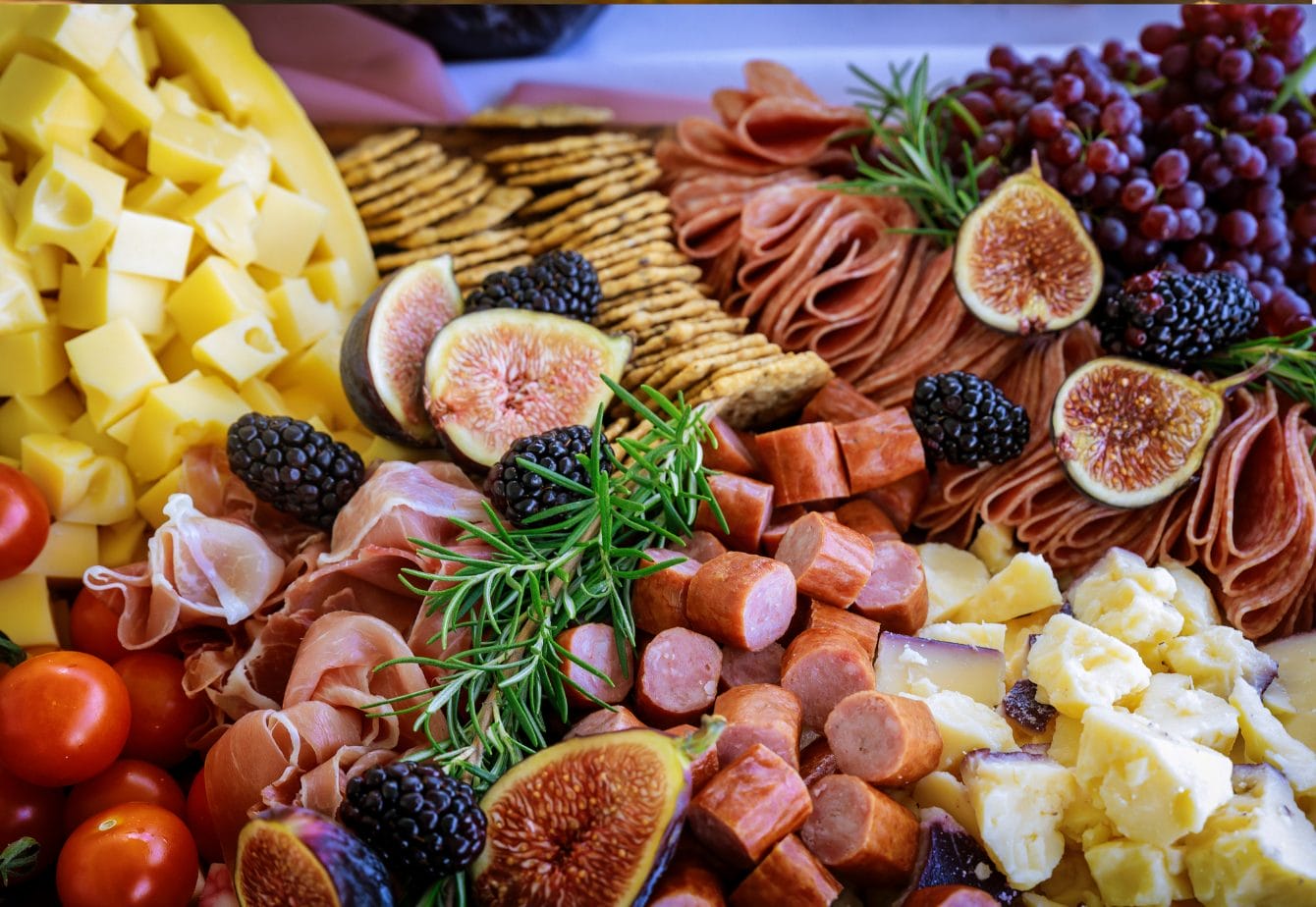
Where To Buy Giant Charcuterie Boards
Finding the perfect giant charcuterie board involves considering both the material and size that best suit your needs. Whether you’re looking for a handcrafted wooden masterpiece or a sleek, modern design, there are several places where you can find high-quality charcuterie boards to fit your event. Here’s a guide to help you locate the ideal board for your gathering.
1. Specialty Kitchenware Stores
Examples:
- Williams Sonoma: Known for high-quality kitchen and dining products, Williams Sonoma offers a variety of stylish and durable charcuterie boards.
- Sur La Table: Offers a selection of boards made from different materials including wood, marble, and slate, ideal for creating impressive presentations.
Why Buy Here:
- Quality: Specialty stores often provide premium options crafted from high-end materials.
- Variety: A range of sizes, materials, and designs to choose from, including customizable options.
2. Online Retailers
Examples:
- Amazon: Features a vast selection of giant charcuterie boards in various materials, sizes, and price ranges. Customer reviews can help guide your choice.
- Etsy: Offers unique, handcrafted charcuterie boards from various artisans. This is a great place to find personalized or custom boards.
Why Buy Here:
- Convenience: Shop from the comfort of your home with delivery options.
- Selection: Wide variety of styles and materials to fit different tastes and budgets.
3. Home Goods and Furniture Stores
Examples:
- Crate & Barrel: Provides elegant and functional charcuterie boards, including larger sizes suitable for entertaining.
- Pottery Barn: Offers high-quality boards often featuring stylish designs and premium materials.
Why Buy Here:
- Style: Often have a curated selection that matches current trends and home decor styles.
- Durability: Boards are usually well-made and designed for frequent use.
4. Local Artisan Markets and Craft Fairs
Examples:
- Local Craft Fairs: Visit local markets to find unique, handcrafted charcuterie boards made by local artisans.
- Farmers Markets: Some farmers markets have vendors specializing in custom or artisanal wooden products.
Why Buy Here:
- Uniqueness: Often offer one-of-a-kind boards with custom designs and finishes.
- Support Local: Buying from local artisans supports small businesses and often provides a more personalized shopping experience.
5. Custom and Specialty Woodworking Shops
Examples:
- Local Woodworking Shops: Many local craftsmen and woodworking shops offer custom charcuterie boards tailored to your specifications.
- Online Custom Shops: Websites like CustomMade.com allow you to design a board to your exact preferences and dimensions.
Why Buy Here:
- Customization: Ability to request specific sizes, shapes, and engravings.
- Craftsmanship: High-quality, often hand-crafted boards made with attention to detail.
Tips for Choosing the Right Giant Charcuterie Board
- Material: Consider materials like hardwood (maple, walnut), marble, or slate for durability and aesthetic appeal. Each material offers different benefits in terms of maintenance and presentation.
- Size and Shape: Ensure the board is large enough to accommodate your needs and choose a shape that fits your serving space and style.
- Ease of Maintenance: Look for boards that are easy to clean and maintain. Wooden boards should be oiled regularly to prevent drying and cracking.
- Design and Style: Choose a design that complements your event theme and personal style. Consider features like built-in handles or compartments for added convenience.
By exploring these options, you’ll be able to find a giant charcuterie board that enhances your event and meets your specific needs.
Wrapping It Up
A giant charcuterie board is more than just a feast—it's a statement piece that adds flair and flavor to any event. By carefully selecting ingredients, experimenting with unique elements, and presenting your board with creativity, you can transform any gathering into a memorable experience. Embrace the opportunity to showcase your culinary artistry and make your next event truly special.

Frequently Asked Questions
What can I use for a giant charcuterie board?
For a giant charcuterie board, use a mix of cheeses, such as cheddar, brie, and gouda; a variety of cured meats like prosciutto and salami; fresh and dried fruits; nuts; olives; and an assortment of spreads like hummus and mustard. Enhance your board with artisanal crackers, breadsticks, and garnishes like fresh herbs and edible flowers for added visual appeal and flavor diversity.
What is a good size for a large charcuterie board?
A good size for a large charcuterie board typically ranges from 18 to 24 inches in diameter for round boards, or 24 to 36 inches in length for rectangular boards. This size allows ample space to showcase a variety of cheeses, meats, fruits, and other accompaniments, making it ideal for serving 10 to 20 guests at gatherings or parties. Adjust the size based on the number of guests and the available serving area.
How much charcuterie do you need for 100 people?
For 100 people, plan on providing approximately 2 to 3 ounces of meat and 2 to 3 ounces of cheese per person. This amounts to about 12 to 18 pounds of meat and 12 to 18 pounds of cheese in total. Additionally, include a variety of accompaniments like fruits, nuts, and crackers, aiming for roughly 1 pound of these items per 10 people. Adjust quantities based on the size of the event and the diversity of the board's offerings.
Share Your Creations:
We’d love to see the charcuterie boards you create using our guide! Feel free to share your own creations in the comments or on social media, and tag us for a chance to be featured. And if you have any other ideas or tips for creating the perfect charcuterie board, we’d love to hear them.

